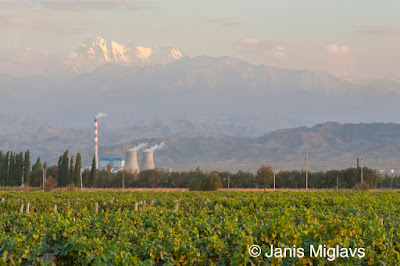Journal: May 12
Peul tribe village of Ibel, remote southeast corner of Senegal
Africa really intimidated
me. Yeah, people called me a “world traveler,” but Sub-Saharan Africa was
bigger than my imagination and, in my mind, full of dark lurking unknown
mysteries.
 |
| A woman carrying a basket on her head walks past one of the family compounds comprising the Peul-tribe village of Ibel (Ebel) in the remotest southeast corner of Senegal, Africa. |
So I’m sleeping in my mosquito-netted REI hammock in
Omar Ba’s family compound. I had chosen this Peul tribe village of Ibel as a
base camp as it was perfectly located below the cliffs where the Bedik lived,
my final destination for a couple of weeks.
 |
| Home Sweet Home in Omar Ba's family compound in Ibel, Senegal, Africa. |
In the 90 F coolness of first light, muffled giggling
and polite little whispers woke me up. Just outside the woven reed fence of
Ba’s little compound, a group of eight curious mostly butt-naked village children wanted
a peek at the visitor.
Putting on my shorts, I waddled into the group. For a
few moments all of us were shy. Then I clumsily uttered the few words of Peul I
knew, “Good night” and “thank you.” I love kids so I started tickle poking a
few in the stomach. A barrier was broken. We all laughed, over and over. In the
commotion, some rubbed their curious little fingers across my arm and giggled
when the white didn’t rub off my skin.
One kid reached out to hold my hand with his small
dirt-encrusted fingers. Then somehow, spontaneously, we all held hands and
started walking in a V-shaped chain like migrating geese. I was at point.
In
the quiet of predawn, wordlessly, we meandered away from the houses. Behind us the
hushed sounds of an awakening village: chickens clucking, roosters crowing,
adults talking quietly as they started the morning cooking fires. It all seemed
so peaceful, so isolated from the rest of the world.
Our little migrating flock wandered across the stubble
of harvested fields. With the wide eyes of a fresh-off-the-boat immigrant, I
looked back over the bobbing heads of the children towards the collection of
thatched-roofed mud huts. Tears of joy streamed down my cheeks. I was swimming
in a river of bliss. “This is real. This isn’t Disneyland,” I whispered to
myself.
 |
| Three little boys running towards the Peul-tribe village of Ibel (Ebel) in the remotest southeast corner of Senegal, Africa. |
I felt totally out of my element, but really alive. I was
a little boy exploring the world in my own adventure movie, playing a bit role
on a tiny planet hurtling through space at 65,000 miles per hour. Inside a tiny crack opened in
some deep part of my being. I was connecting with something I didn’t
understand.
Here I was sharing sheer joy together with a group of
kids from a different culture, a different language, a different religion, a
different ethnic race. Where were the barriers?
I
looked down at the dusty-faced children and wondered if they too saw the world
differently holding my hands. For those 15 or 20 minutes of our walk, I
regained the innocent joy of these little kids.
Later that day, I wondered what was it that allowed us,
from two totally different situations, to share such a moment of collective
ecstasy, of being so alive?
Then in my wildest dreams I dared to wonder what would happen if this feeling of
collective joy spread around the world, even for a few moments every day?
Why not? This is Africa, we all originated here.
 |
Villagers watch as a local bus crammed with people from the Peul-tribe village of Ibel (Ebel) head away. Senegal, Africa.
All photographs and text © 2015 Janis Miglavs
www.jmiglavs.com
www.FiveFingersProject.org
janis@jmiglavs.com |









































